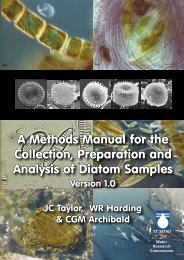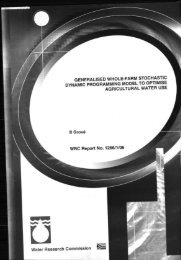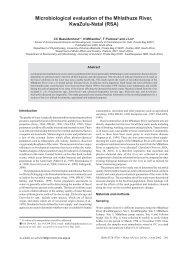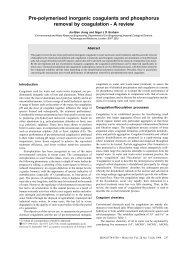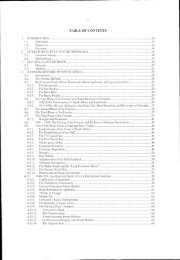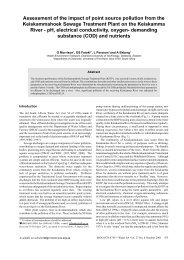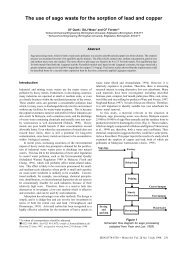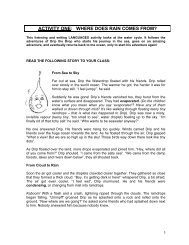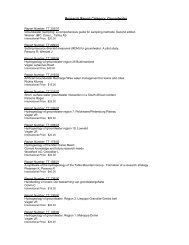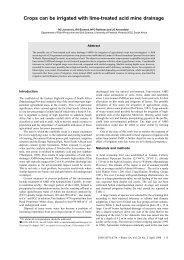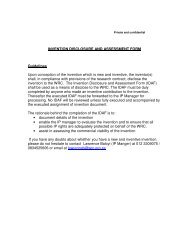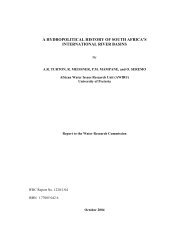and the Efficacy of Pit Latrine Additives - Water Research Commission
and the Efficacy of Pit Latrine Additives - Water Research Commission
and the Efficacy of Pit Latrine Additives - Water Research Commission
- No tags were found...
You also want an ePaper? Increase the reach of your titles
YUMPU automatically turns print PDFs into web optimized ePapers that Google loves.
To test samples <strong>of</strong> a commercially available pit additive <strong>and</strong> corresponding placebos by recording <strong>the</strong>ir<br />
effect over a period <strong>of</strong> two weeks<br />
To familiarise <strong>the</strong> researchers, through first h<strong>and</strong> experience, with various factors important to an<br />
underst<strong>and</strong>ing <strong>of</strong> filling rates <strong>and</strong> pit latrine sanitation management in general<br />
<br />
To enable <strong>the</strong> researchers to plan relevant <strong>and</strong> effective future studies aimed at investigating pit latrine<br />
sanitation problems <strong>and</strong> challenges<br />
4.3.2 Methodology<br />
The study was conducted in Mpumuza, a peri-urban but rural area northwest <strong>of</strong> Pietermaritzburg. A total <strong>of</strong> 9<br />
pits were monitored. Four latrines belonging to private residences <strong>and</strong> four scholars' pit latrines at a primary<br />
school were visited, described <strong>and</strong> tested. One <strong>of</strong> <strong>the</strong> privately owned facilities comprised a double latrine<br />
with two separate pits <strong>and</strong> pedestals, both currently in use. The four school latrines were selected from a<br />
total <strong>of</strong> 19 latrines.<br />
The nine pits were visited between 9 <strong>and</strong> 11 am on three occasions, one week apart, on 27/2/07, 6/3/07 <strong>and</strong><br />
13/3/07. During <strong>the</strong> initial visit, owners, users or occupants were questioned to establish <strong>the</strong> age <strong>of</strong> <strong>the</strong><br />
latrine, number <strong>of</strong> users, on-site alternatives <strong>and</strong> any intermittent or routine management practices (adding <strong>of</strong><br />
Jeye's fluid, dip, ash, or o<strong>the</strong>r).<br />
The latrine design <strong>and</strong> <strong>the</strong> appearance <strong>of</strong> <strong>the</strong> structure <strong>and</strong> <strong>the</strong> contents <strong>of</strong> <strong>the</strong> pit were described <strong>and</strong><br />
recorded. The contents <strong>of</strong> <strong>the</strong> pit viewed through <strong>the</strong> seat <strong>and</strong> <strong>the</strong> external structure were photographed. The<br />
coordinates <strong>of</strong> each site were recorded using a h<strong>and</strong> held Garman GPS.<br />
Using a graduated, weighted string, <strong>the</strong> distance from <strong>the</strong> underside <strong>of</strong> seat to <strong>the</strong> highest point <strong>of</strong> <strong>the</strong> heap<br />
was measured at each visit while <strong>the</strong> height <strong>of</strong> <strong>the</strong> pedestal (from <strong>the</strong> underside <strong>of</strong> seat to <strong>the</strong> underside <strong>of</strong><br />
slab) was recorded at <strong>the</strong> first visit. In addition <strong>the</strong> height <strong>of</strong> <strong>the</strong> heap in relation to <strong>the</strong> lowest point in <strong>the</strong> pit<br />
(at <strong>the</strong> back wall) was estimated by eye<br />
Table 4.2: R<strong>and</strong>om allocation <strong>of</strong> additives <strong>and</strong> placebos in study pits, weeks 1 to 3<br />
<strong>Pit</strong> <strong>Latrine</strong> Week 1 (27/2/07) Week 2 (6/3/07) Week 3 (13/3/07)<br />
1 A 1 P 1 P 1<br />
2 P 1 A 1 P 1<br />
3 P 2 A 1 P 1<br />
4 A 2 P 1 P 1<br />
5 P 1 P 1 P 1<br />
6 P 1 A 1 P 1<br />
7 A 2 A 1 P 1<br />
8 P 2 P 1 P 1<br />
9 A 1 A 1 P 1<br />
A 1 = White, powdery pit additive (7 samples; 2 administered week 1 <strong>and</strong> 5 week 2)<br />
A 2 = Coarse, brown pit additive (2 samples; administered in week 1)<br />
P 1 = White CMC placebo (3 added week 1, 4 week 2 <strong>and</strong> 9 week 3)<br />
P 2 = Layer mash placebo (2 added week 1)<br />
The manufacturer said that <strong>the</strong> two samples tested contained <strong>the</strong> same “active ingredient” but were mixed<br />
with two different bulking agents. One set <strong>of</strong> samples (7) contained a uniform white powder (according to <strong>the</strong><br />
manufacturer this was calcium carbonate to “enhance oxygen necessary for activation <strong>of</strong> bacteria”) <strong>and</strong> <strong>the</strong><br />
second (2 samples) was a coarser, less dense brown mixture resembling chicken food mash (described as a<br />
bran carrier). Total number <strong>of</strong> samples was 9.<br />
41



